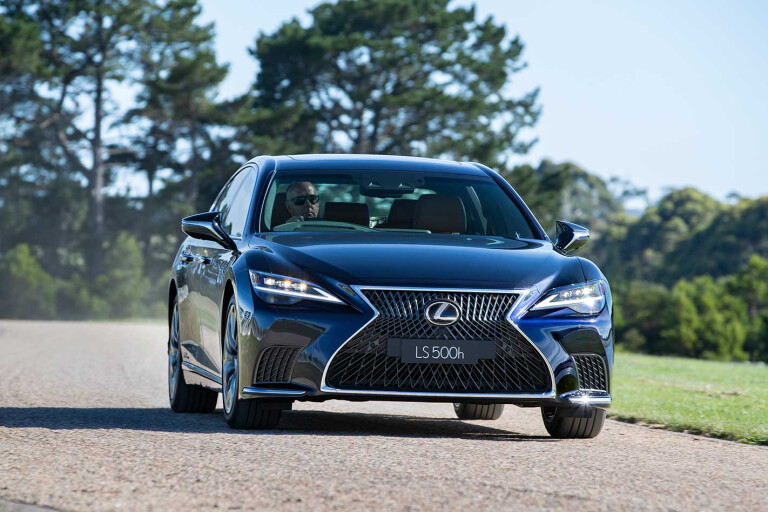
Things we like
- Incredible amount of kit
- Impressive ride
- Interior craftsmanship
- Fuel economy
Not so much
- Twin-turbo engine a better fit
- Hybrid robs boot space and loses cooler box
- Weight
The Lexus LS500h Sports Luxury is the epitome of Lexus values. As the brand’s flagship, it signifies everything it knows about interior craftsmanship, engineering attention to detail and cutting-edge technology.
In newly updated 2021 guise, Lexus’ engineers have left no stone unturned in their efforts to improve comfort and refinement, resulting in an interesting alternative to the German duo (Mercedes-Benz S-Class and BMW 7 Series) that dominate the limousine segment.
The LS Sports Luxury is available with a 310kW/600Nm 3.5-litre twin-turbo V6 or the 264kW hybrid tested here, which teams a 220kW/350Nm 3.5-litre V6 with a 132kW/300Nm electric motor.
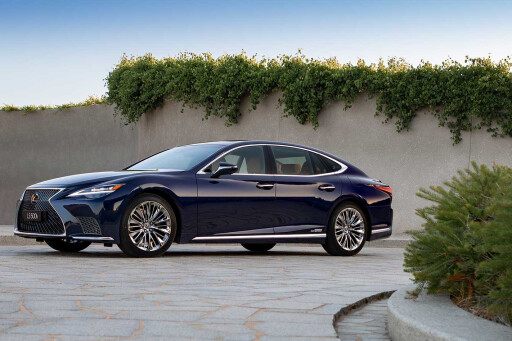 Both variants cost $201,078 before options and on-road costs, which according to the Lexus website translates to $214,940 driveway in Sydney and $223,775 in Melbourne, but pop your postcode in to find the relevant pricing for your location.
Both variants cost $201,078 before options and on-road costs, which according to the Lexus website translates to $214,940 driveway in Sydney and $223,775 in Melbourne, but pop your postcode in to find the relevant pricing for your location.
Presumably, LS owners aren’t necessarily concerned with value but this undercuts all main rivals, including the Audi A8 LWB (from $208,889), BMW 740Li ($234,900) and newly unveiled Mercedes-Benz S-Class LWB (from $264,900).
Options are few and far between. None of the 10 colours, of which Sonic Quartz (a metallic white) is exclusive to the Sports Luxury, attract an extra charge but if you really want to give Lexus extra money you can opt for one of the impressive optional interior trims.
A number of ‘ornamentation’ options, as Lexus calls them, are available for no extra cost with various colour combinations. Black interiors offer leather or fabric door trims with laser-cut wood that reveals a pattern from the metal below, or the impressive ‘Nishijin & Haku’ interior (+$10,000) that uses silver threads and platinum in an attempt to make the door inserts mimic the play of moonlight on the open sea. This is paired with a very thin film of platinum for the ornamentation.
 White and crimson interiors are also available with laser cut ornamentation, the latter also being paired with Kiriko glass (+$10,000), a bold look that uses pleated door inserts and cut glass that changes look as the interior lighting conditions change.
White and crimson interiors are also available with laser cut ornamentation, the latter also being paired with Kiriko glass (+$10,000), a bold look that uses pleated door inserts and cut glass that changes look as the interior lighting conditions change.
The pale Chateau interior is paired with more traditional herringbone and hazel wood while the ultimate in leather, dubbed ‘L-aniline’, is also available for $10,000 in black or ochre. It’s worth considering, as it does feel beautiful to touch.
What’s included as standard is a mind-boggling array of comfort, convenience and safety technology. Starting with the former, the LS Sports Luxury includes power-operated seats front and rear with heating, ventilation and massage functionality, the rear passenger seat able to recline business-class style (with footrest!) courtesy of the touchscreen in the fold-down rear centre armrest.
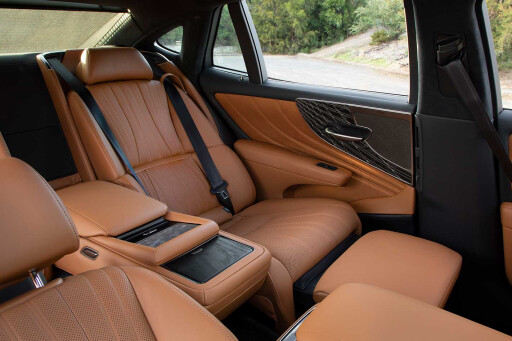
This also controls the quad-zone climate control, the dual 11.6-inch entertainment screens (with HDMI input) mounted on the back of the front seats and the rear and side electric sunshades. The Sports Luxury also scores another two airbags, bringing the total to 12, with additional protection for the rear seat cushions.
In the twin-turbo Sports Luxury models there is also a cooler box between the rear seats to keep the drinks chilled, but sadly this is not available in the hybrid.
Up front are 28-way adjustable powered front seats, a heated steering wheel, 23-speaker Mark Levinson stereo with subwoofer, a digital rear-view mirror, sunroof and a new 12.3-inch infotainment screen with digital radio, DVD player, USB and AUX input and smartphone mirroring.
 Happily, this panoramic screen now has touch functionality, as despite some improvements the usual Lexus touchpad is still far from slick in its operation. One neat feature of the F Sport that’s unfortunately denied the Sports Luxury is the LFA-style instrumentation with the sliding outer ring. It never fails to impress, but the huge colour head-up display (600 x 150mm) ahead of the driver displays speed and navigation information.
Happily, this panoramic screen now has touch functionality, as despite some improvements the usual Lexus touchpad is still far from slick in its operation. One neat feature of the F Sport that’s unfortunately denied the Sports Luxury is the LFA-style instrumentation with the sliding outer ring. It never fails to impress, but the huge colour head-up display (600 x 150mm) ahead of the driver displays speed and navigation information.
When it comes to safety, the LS wants for little. As well as those 12 airbags, there is a vast suite of active safety programs, including the Pre-Collision System (pre-collision warning, brake assist and braking, day- and night-time pedestrian detection, daytime cyclist detection, intersection turn assist), active radar cruise control (lane keep assist, lane tracing assist, road sign recognition, blind-spot monitoring) and Lexus Connected Services, which includes stolen vehicle tracking, automatic collision notification and an SOS button in the overhead console to request emergency assistance.
Lexus has also tweaked the LS mechanicals for greater comfort and refinement. The hybrid's electric motor provides greater assistance and the transmission’s shift strategy has been altered to improve low-end response, while the speed range in which electric-only operation is possible has been expanded from 70km/h to 129km/h.
 It’s claimed the LS500h is capable of 0-100km/h in 5.4sec, just 0.4sec slower than its more powerful sibling, but to be honest that feels extremely optimistic. You don’t have to be a genius to work out that 264kW propelling up to 2340kg of limo won’t make for rapid progress.
It’s claimed the LS500h is capable of 0-100km/h in 5.4sec, just 0.4sec slower than its more powerful sibling, but to be honest that feels extremely optimistic. You don’t have to be a genius to work out that 264kW propelling up to 2340kg of limo won’t make for rapid progress.
That said, when set to Sport+ the transmission’s shift programming is outstanding and keeps the V6 singing above 5000rpm where it does its best work. Strange as it may sound, the hybrid is actually the sportier engine choice, at least in character if not outright performance.
Where the hybrid makes the most sense, though, is in an urban environment where the efficiency of the petrol-electric drivetrain dramatically cuts fuel use. Around town, Lexus claims the LS500h uses just 7.8L/100km compared to 14.2L/100km for the twin-turbo petrol. This drops to 6.2L/100km on the highway, which gives the hybrid a theoretical range of more than 1300km!
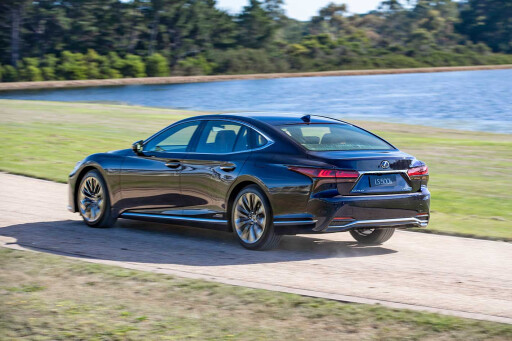 Improving the ride clearly wasn’t easy, as engineers had to dig deep to find gains. The 20-inch wheels use a ‘hollow chamber’ design to reduce unsprung weight and noise, the control valve for the adaptive suspension has been enlarged to lower damping force, new larger, liquid-filled bushes are installed in the lower control arms and a new bound stopper reduces front suspension stroke friction by 30 per cent.
Improving the ride clearly wasn’t easy, as engineers had to dig deep to find gains. The 20-inch wheels use a ‘hollow chamber’ design to reduce unsprung weight and noise, the control valve for the adaptive suspension has been enlarged to lower damping force, new larger, liquid-filled bushes are installed in the lower control arms and a new bound stopper reduces front suspension stroke friction by 30 per cent.
Even the tyres were changed, Bridgestone developing a run-flat tyre with a lower vertical spring rate, in the name of added comfort. It works, as the LS Sports Luxury is plush on the majority of surfaces with the ride you’d expect from a car of this class.
The Sports Luxury lacks the handling toys of the F Sport model, including wider rear wheels and tyres, bigger brakes, rear-wheel steering and active anti-roll bars but it doesn’t really miss them. It still has fine balance for such a big car and it’s questionable whether any LS owner is really going to explore the outer dynamic limits.
If you judge a luxury car by the experience it provides, particularly to rear-seat passengers, then the LS Sports Luxury scores highly. Reclined in the back of the whisper-quiet LS, watching a movie with the massage seat on and the climate set just so would be a fabulous way to while away a long interstate journey.
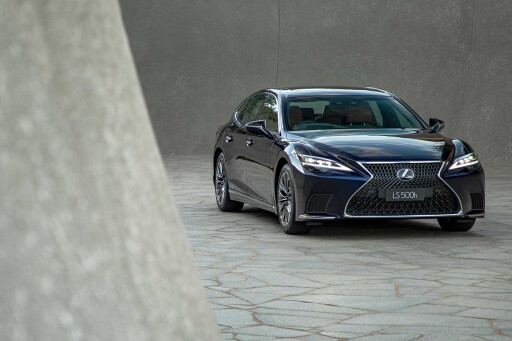 The LS ownership experience extends beyond the car, too. Lexus will provide a loan car during servicing – the first three services are capped at $595 each – and you also enter the privileged world of the Encore Platinum program.
The LS ownership experience extends beyond the car, too. Lexus will provide a loan car during servicing – the first three services are capped at $595 each – and you also enter the privileged world of the Encore Platinum program.
This gives buyers of Lexus’ flagship models entry of exclusive events, money-can’t-buy experiences with Lexus ambassadors, special offers at partner accommodation and access to the Lexus on Demand program, which allows the use of Lexus vehicles when travelling interstate for a maximum of eight days, four times over three years.
In Sports Luxury guise the LS is an intriguing proposition. It won’t be for everyone, but its delivery of the Lexus brand values will appeal to those wanting to stand out from the luxury crowd.
Specifications
- Body: 4-door, 5-seat sedan
- Drive: rear-wheel
- Engine: 3456cc V6, DOHC, 24v
- Bore/stroke: 94 x 83mm
- Compression: 13.0:1
- Power: 220kW @ 6600rpm
- Torque: 350Nm @ 5100rpm
- Electrical output: 132kW/300Nm
- Total output: 264kW
- 0-100km/h: 5.4sec (claimed)
- Fuel consumption: 6.6L/100km (combined/claimed)
- Weight: 2340kg
- Power/weight: 113kW/tonne
- Transmission: multi-stage hybrid
- Suspension: multi-links, air springs, adaptive dampers, anti-roll bars (f/r)
- L/W/H: 5235/1900/1450mm
- Wheelbase: 3125mm
- Tracks: 1631/1637mm
- Steering: electrically assisted rack-and-pinion
- Brakes: 357mm ventilated discs, 4-piston calipers (r); 335mm ventilated discs, 2-piston calipers (r)
- Wheels: 20.0-inch (f/r)
- Tyres: 245/45 R20 (f/r) Bridgestone Turanza
- Price: $201,078
Things we like
- Incredible amount of kit
- Impressive ride
- Interior craftsmanship
- Fuel economy
Not so much
- Twin-turbo engine a better fit
- Hybrid robs boot space and loses cooler box
- Weight
COMMENTS